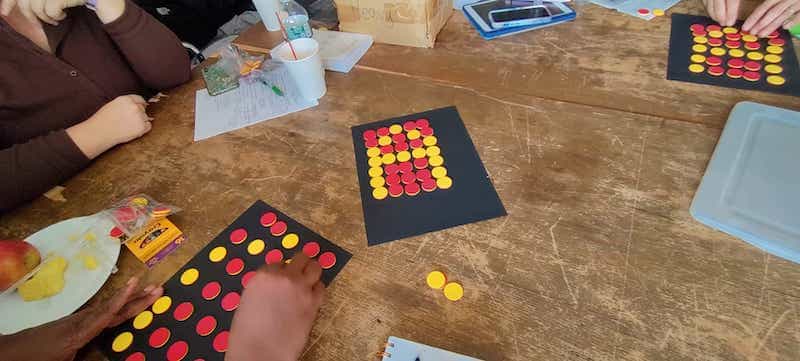
Module 3
Computers Unwrapped

Constructing 5×7 matrix displays like those used on NYC subways to show the train line – the A in this case.
The materials described below have been part of undergraduate and graduate courses at City College School Education and have been tested in upper-grade elementary classrooms in Central Brooklyn public schools. These materials consist of units on Circuits, Codes, Information and Communication. Each unit is summarized below.
This unit begins with the construction of simple circuits including an LED and coin battery. Students are challenged to make the LED light up, and then to make and include switches in their circuits. They then explore the operation of this simple circuit using a circulating penguin toy as a model for explaining electrical concepts. Finally, students create “electric puppets” whose two eyes light up when a hidden switch is closed.
This unit begins with symbols, which are the components of codes. Students identify common graphic symbols, such as those found on common signs. A code is just a system of symbols. A key is a translation of a code into everyday language. Students create keys for their favorite emojis. Then they learn binary code, which is used by all computers, and uses only two symbols, 0 and 1. Finally they translate their birthdates into bninary and create display that express their binary birthdates using LEDs.
Computers use codes to represent information. Two forms of information are analog and digital, which they explore by sorting common devices. The basic unit of digital information is the bit, which stands for binary digit, and could be either a 0 or a 1. To measure the amount of information in a muber, students play a number guessing game. Finally, students create alphanumeric display schemes using crayons or counters.
Here we develop the solution to the problem of getting data from one place to another. Communication involves a source, a receiver and a channel. Often one of these components introduces errors in the message. Redundancy is used in both ordinary life and in computers to detect and or correct errors in transmission. Computers use parity bits to add redundancy. Students explore parity by learning a “magic trick” that uses parity to correct an error introduced deliberately in a 5 x 5 grid of counters.